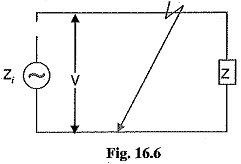Short Circuit in Power System:
Whenever a fault occurs on a network such that a large current flows in one or more phases, a Short Circuit in Power System is said to have occurred.
When a short circuit occurs, a heavy current called short circuit current flows through the circuit. This can be beautifully illustrated by referring to Fig. 16.6 where a single phase generator of voltage V and internal impedance Zi is supplying to a load Z. Under normal conditions, the current in the circuit is limited by load impedance Z. However, if the load terminals get shorted due to any reason, the circuit impedance is reduced to a very low value ; being Zi in this case. As Zi is very small, therefore, a large current flows through the circuit. This is called Short Circuit Current. It is worthwhile to make a distinction between a short circuit and an overload.
When a Short Circuit in Power System occurs, the voltage at fault point is reduced to zero and current of abnormally high magnitude flows through the network to the point of fault. On the other hand, an overload means that loads greater than the designed values have Fig. 16.6 been imposed on the system. Under such conditions, the voltage at the overload point may be low, but not zero. The under voltage conditions may extend for some distance beyond the overload point into the remainder of the system. The currents in the overloaded equipment are high but are substantially lower than that in the case of a Short Circuit in Power System.
1. Causes of short-circuit: A short circuit in the power system is the result of some kind of abnormal conditions in the system. It may be caused due to internal and/or external effects.
- Internal effects are caused by breakdown of equipment or transmission lines, from deterioration of insulation in a generator, transformer Such troubles may be due to ageing of insulation, inadequate design or improper installation.
- External effects causing Short Circuit in Power System include insulation failure due to lightning surges, overloading of equipment causing excessive heating; mechanical damage by public etc.
2. Effects of short-circuit: When a short-circuit occurs, the current in the system increases to an abnormally high value while the system voltage decreases to a low value.
- The heavy current due to short-circuit causes excessive heating which may result in fire or Sometimes short-circuit takes the form of an arc and causes considerable damage to the system. For example, an arc on a transmission line not cleared quickly will burn the conductor severely causing it to break, resulting in a long time interruption of the line.
- The low voltage created by the fault has a very harmful effect on the service rendered by the power system. If the voltage remains low for even a few seconds, the consumers’ motors may be shut down and generators on the power system may become unstable.
Due to above deterimental effects of Short Circuit in Power System, it is desirable and necessary to disconnect the faulty section and restore normal voltage and current conditions as quickly as possible.
Short Circuit Currents:
Most of the failures on the power system lead to short-circuit fault and cause heavy current to flow in the system. The calculations of these short-circuit currents are important for the following reasons :
- A short-circuit on the power system is cleared by a circuit breaker or a fuse. It is necessary, therefore, to know the maximum possible values of short-circuit current so that switchgear of suitable rating may be installed to interrupt them.
- The magnitude of Short Circuit in Power System current determines the setting and sometimes the types and location of protective system.
- The magnitude of short-circuit current determines the size of the protective reactors which must be inserted in the system so that the circuit breaker is able to withstand the fault current.
- The calculation of short-circuit currents enables us to make proper selection of the associated, apparatus (e.g. bus-bars, current transformers etc.) so that they can withstand the forces that arise due to the occurrence of short circuits.
Faults in a Power System:
A fault occurs when two or more conductors that normally operate with a potential difference come in contact with each other. These faults may be caused by sudden failure of a piece of equipment, accidental damage or Short Circuit in Power System to overhead lines or by insulation failure resulting from lightning surges. Irrespective of the causes, the faults in a 3-phase system can be classified into two main categories viz.
(i) Symmetrical faults (ii) Unsymmetrical faults
- Symmetrical faults: That fault which gives rise to symmetrical fault currents (i.e. equal faults currents with 120° displacement) is called a symmetrical fault. The most common example of symmetrical fault is when all the three conductors of a 3-phase line are brought together simultaneously into a short-circuit condition.
- Unsymmetrical faults: Those faults which give rise to unsymmetrical currents (i.e. unequal line currents with unequal displacement) are called unsymmetrical faults. The unsymmetrical faults may take one of the following forms :
